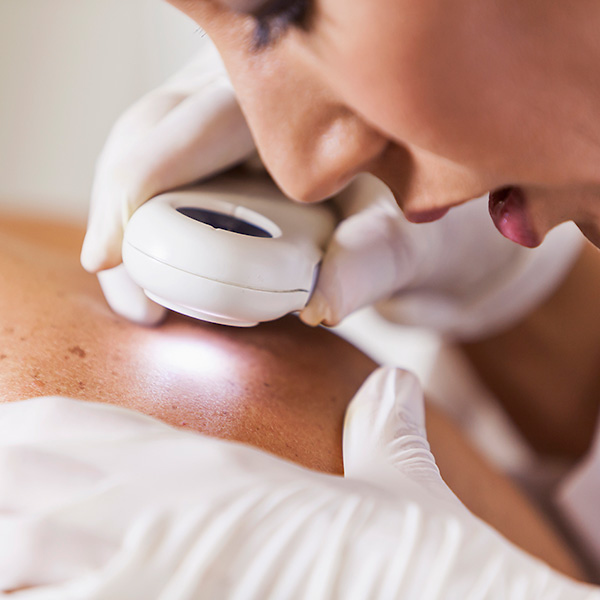Mohs Surgery
Advanced Surgical Treatment for Skin Cancer
Loyola Medicine’s Skin Cancer and Mohs Micrographic Surgery Center is a comprehensive treatment center for skin cancer. Recognized as one of the top medical centers for cancer treatment, Loyola is proud to offer you the latest in skin cancer treatment with Mohs surgery.
Our interdisciplinary team includes a fellowship-trained Mohs surgeon, medical oncologists and surgical oncologists, reconstructive surgeons, radiologists and dermatopathologists. Our team is committed to the highest quality of care and superior outcomes for our patients.
Mohs surgery is a highly specialized technique that combines surgical removal of skin cancer with immediate microscopic review of the tissue. The surgical procedure, performed by a fellowship-trained Mohs surgeon, is a precise technique that offers:
- Highest potential cure rate, up to 99% for skin cancer
- Minimal risk of recurrence
- Protection of healthy tissue, superior cosmetic results and minimal scarring
- Removal of all skin cancer cells at the margins
New treatments for skin cancer are evolving rapidly, and Mohs surgery is widely recognized as one of the most effective methods for treating skin cancer.
Mohs surgery is most often associated with the removal of basal and squamous cell carcinoma, the two most common skin cancer types, but can also be used to treat some kinds of other skin cancers.
What Happens During Mohs Surgery?
Mohs surgery is performed in your doctor’s office under local anesthetic.
After marking and numbing the area, the Mohs surgeon will remove the visible part of the tumor, along with a thin layer of skin around and below it. Dyes are used to map and pinpoint the malignant (tumor) cells on a microscope slide.
If cancer cells are found under the microscope, the surgeon marks their location on the map and removes an additional layer of skin where cancer cells were found.
This process of removing precise layers of skin is repeated until all cancer cells are gone. After the skin cancer is entirely removed, the wound will be reconstructed. For most skin cancers, the Mohs procedure and the reconstructive surgery can be performed on the same day.
What Happens After Mohs Surgery?
Loyola is committed to ensuring that you get the best possible care from beginning to end. After your procedure, our staff will explain wound care instructions to you and schedule a follow-up visit to remove your stitches.
Following the removal of your tumor, we recommend routine skin examinations with your dermatologist every six months to ensure rapid detection and treatment of any recurring skin cancer.
What are the Risks of Mohs Surgery?
Loyola’s doctors are very experienced at performing Mohs surgery. Therefore, the risks associated with the procedure are minimal, but may include:
- Bleeding from the wound
- Hematoma (bleeding into the wound)
- Infection
- Tenderness around the surgical site
In rare instances, more serious complications could occur, which include:
- Itching or sharp pain
- Keloid scars
- Temporary or permanent muscle weakness
- Temporary or permanent numbness surrounding the area
Frequently Asked Questions about Mohs Surgery
Mohs surgery is often done on tumors in highly visible and sensitive areas such as the nose, eyelids or lips. Mohs surgery also works well for large areas of skin cancer, when the edges of the tumor are unclear, and for cancer that was previously treated or is fast growing.
Mohs surgery enables a five-year cure rate of up to 99% for new cancers and up to 95% for recurring cancers.
During an extra year of training, your Mohs surgeon studied the surgical technique for removing skin tumors; pathology to study tumors microscopically and map them; and reconstruction to restore the skin where the tumor was removed. Your specialist at Loyola has earned certification from the American College of Mohs Surgeons.
You can expect to arrive in the morning and may spend almost a whole day to complete the surgery and reconstruction.
Any type of surgery for skin cancer leaves a scar. During reconstruction, your surgeon will work to minimize any scarring and will discuss how to get the best possible result. If you need a skin graft, the surgeon may use a small section of skin from someplace unnoticeable, such as behind your ear. A resurfacing procedure may be performed to enhance the end result.
Mohs surgery is specially designed to allow surgeons to discover, map and remove the tiny roots of skin tumors that can cause them to recur. Surgery continues until there is no evidence of cancer at the microscopic level.

Request an Appointment
Loyola Medicine is nationally recognized for its expertise in diagnosing and treating a broad range of skin conditions and providing integrated services for the complete care of your skin. Schedule an appointment with a Loyola Medicine dermatologist today.
Schedule a Telehealth Appointment
